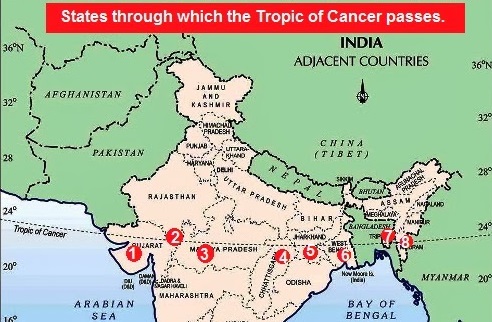These MCQs are based on Today’s Targets given here
Q.1) Tropic of Cancer does not pass through which of the following states:
a) Rajasthan
b) Odisha
c) Tripura
d) Mizoram
Ans. B
Explanation:

Q.2) Consider the following statements about National Adaptation Fund for Climate Change (NAFCC):
1. Under NAFCC 100% central grant is provided to the State Governments for implementing climate change adaptation projects.
2. The National Bank for Agriculture and Rural Development (NABARD) is the National Implementing Entity (NIE) responsible for implementation of adaptation projects under the NAFCC.
Select the correct answer using the code given below:
a) 1 only
b) 2 only
c) Both 1 and 2
d) Neither 1 nor 2
Ans. C
Explanation:
- Under NAFCC 100% central grant is provided to the State Governments for implementing climate change adaptation projects.
- The Scheme has been designed to fulfill the objectives of National Action Plan on Climate Change (NAPCC) and operationalize the State Action Plans on Climate Change (SAPCCs).
- The objective of the fund is to assist states/UTs that are particularly vulnerable to the adverse effects of climate change in meeting the cost of adaptation.
- The National Bank for Agriculture and Rural Development (NABARD) is the National Implementing Entity (NIE) responsible for implementation of adaptation projects under the NAFCC.
- Under this scheme, Union Government encourages States to come up with innovative and scalable projects to develop resilience against climate change and mainstream it in the planning processes.
Q.3) Consider the following statements:
1. Coral reefs are natural structures built from the natural work of little polyps budded on top of one another.
2. They are primarily located between 30 degree north/south and poles.
Select the correct answer using the code given below:
a) 1 only
b) 2 only
c) Both 1 and 2
d) Neither 1 nor 2
Ans. A
Explanation: http://www.ias4sure.com/wikiias/prelims/coral-reefs-and-coral-bleaching/
Q.4) Consider the following statements:
1. Between eighth and thirteenth centuries trabeate style was used in the construction of temples, mosques, tombs however from the twelfth
century “arcuate” architectural form became prominent
2. In “arcuate” form the “keystone” at the centre of the arch transferred the weight of the superstructure to the base of the arch
Select the correct answer using the code given below:
a) 1 only
b) 2 only
c) Both 1 and 2
d) Neither 1 nor 2
Ans. C
Explanation: Between the seventh and tenth centuries architects started adding more rooms, doors and windows to buildings. Roofs, doors and windows were still made by placing a horizontal beam across two vertical columns, a style of architecture called “trabeate” or “corbelled”. Between the eighth and thirteenth centuries the trabeate style was used in the construction of temples, mosques, tombs and in buildings attached to large stepped-wells (baolis). (Also see Fig 5a)
Two technological and stylistic developments are noticeable from the twelfth century. (1) The weight of the superstructure above the doors and windows was sometimes carried by arches. This architectural form was called “arcuate”. (2) Limestone cement was increasingly used in construction.
Source: NCERT 7th: Our Past – II, Chapter 5, Page 62, 63
Q 5. Consider the following statements:
i) Landfill is an area where the garbage collected from a city or town is dumped. The area is later converted into a park.
ii) Converting plant and animal waste including that from kitchen, into manure, is called composting.
iii) The method of making compost from kitchen garbage using silkworms is called vermicomposting.
Which of the following are true?
a) Only i)
b) Only ii)
c) Only ii) and iii)
d) Only i) and ii)
Ans. D
Explanation:
Landfill is an area where the garbage collected from a city or town is dumped. The area is later converted into a park. Hence statement i) is true.
Converting plant and animal waste including that from kitchen, into manure, is called composting. Hence statement ii) is true.
The method of making compost from kitchen garbage using redworms is called vermicomposting. Hence statement iii) is not true.
Explanation to Q-5 is correct but answer is wrong.
Thanks. Rectified.
You are omnipresent! 🙂
Dayum. I got caught 😛
Ill attempt your history questions in a day or two as well. hahaha